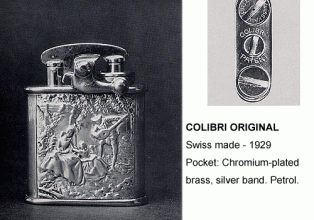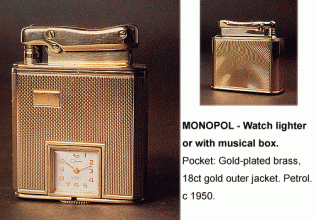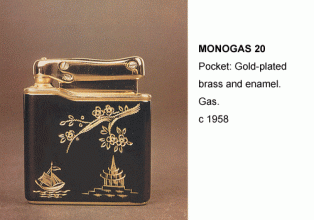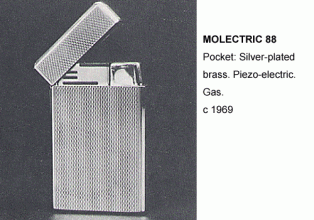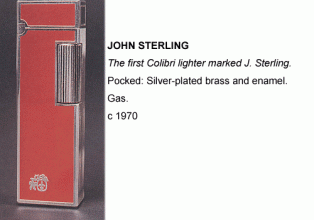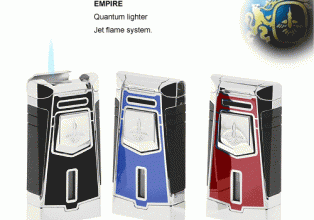 The first Colibri lighter was produced in 1928, but the founder of the firm, Julius Lowenthal had joined a firm specialising in ‘smoker’s requisites’ in 1910 when only 18 years of age. He was therefore involved with lighters almost at their inception. After the First World War, he formed a company with his brother Benno, J. & B. Lowenthal (JBELO), and in 1927, Julius perceived the idea of a lighter which would avoid the thumbs direct contact with the flint wheel. Thus what was known as a COLIBRI ORIGINAL was born.
The first Colibri lighter was produced in 1928, but the founder of the firm, Julius Lowenthal had joined a firm specialising in ‘smoker’s requisites’ in 1910 when only 18 years of age. He was therefore involved with lighters almost at their inception. After the First World War, he formed a company with his brother Benno, J. & B. Lowenthal (JBELO), and in 1927, Julius perceived the idea of a lighter which would avoid the thumbs direct contact with the flint wheel. Thus what was known as a COLIBRI ORIGINAL was born.
As often with lighters, technical difficulties had to be overcome, but the lighter became a huge success, and some COLIBRI Original’s are still giving excellent service to their owners. In the 1930s the company obtained a patent for a fully automatic lighter which virtually guaranteed ignition every time – the , the first made in Switzerland as were the ‘Originals’.
At about that time (1933), Julius Lowenthal moved from Germany to London where he established Colibri Lighters Ltd. His brother Benno, who had previously moved to Switzerland, also followed to London to form his own lighter company BENLOW. Their sister Meta remained to manage the Company in Germany (IBELO). Colibri lighters in London and IBELO in Germany were able to resume working together in 1945.
In the post-war years, Colibri had its own Development Dept. and there began a series of technical developments which have produced and still are for that matter, a while range of exciting new lighters.
In 1955 saw the first Colibri Gas Lighter. This was produced in France where the knowledge existed and combined French advances in butane gas tanks and precision mechanism of the Colibri Monopol.
Out came the Colibri Monogas in a variety of finishes and a number of action improvements. 1958 also saw the first visible multiple gas refill by Colibri and in 1963 the Colibri Autoflint which insured regular pressure.
In 1961 Colibri invented the Piezo Electric lighter and it took many years to perfect the Piezo system which was marketed in 1967 under the name COLIBRI MOLECTRIC 80, itself suspended two years later by the COLIBRI MOLETRIC 88, still one of the most reliable, practical and elegant of lighters.
For the students of ‘such events’, it is worth noting that in the James Bond film ‘The Man with the Golden Gun’, it was Colibri who produced the highly ingenious golden gun which was assembled from a Colibri 88, cigarette case, cuff links and a fountain pen.
Further developments followed. It has always been difficult for example to produce a fully-automatic model totally smooth in appearance. Colibri solved the problem and in 1967, the first models on sale were the COLIBRI MONOMATIC and COLIBRI TETRA.
hese two versions were replaced by the COLIBRI L’AMBASSADEUR and COLIBRI ENVOY and by the COLIBRI SUPERTRONIC, a luxurious battery model, paving the way to the long slim lighters popular today.
The next step was to make a lighter that required no moving parts for ignition. The answer in 1977 was the COLIBRI SENSATRON, operated by the merest touch.
This year (sic 1982), two new models were presented and offered a double ‘presentation’ in that Colibri had sealed an agreement with COMOYs / ORLIK for the distribution of Colibri Lighters in the UK.
The first is the COLIBRI JETRIC 10 which represents a totally new and convenient way of achieving a closed lidded lighter. Instead having to lift the lid with the thumb and moving it to operate the actuator, the Jetric system releases the lid which swings open from the top of the corner of the lighter. It is a very fine lighter in a number of beautiful finishes and it sells in the shops from £14.95 to £19.95 (sic 1982), excellent value.
Colibri describe the other model, the COLIBRI LASATRON as the first truly ‘Space age Lighter’. In this, the ignition has been further simplified: having opened the lid, the beam is sent across a recess onto a photoelectric sensitive cell. To ignite the lighter, one just passes one’s finger across the beam. This is really keeping up with the microchip technology.
Looking through the Colibri range, we find no less than 20 different models, some in six finishes, representing over 100 ‘combinations’. While most models are suitable to light a pipe, pipe smokers are not overlooked. Out of two models, the PIPEMAN and the PIPER, we found the PIPEMAN more interesting. With a side-wheel action it is a ‘traditional’ design, made out of solid brass, long in the modern way and a good capacity tank. The flame comes out sideways and can easily be controlled. It holds simply in one hand and therefore very useful when the other hand is otherwise engaged.

